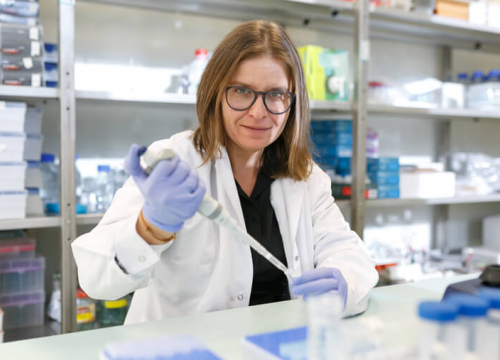How SARS-CoV-2 infection affects our body's stem cells

More than 20 months ago, the scientific community was faced with the enormous challenge of the global SARS-CoV-2 pandemic. The first studies on the mechanism of SARS-CoV-2 infection, conducted by a huge number of scientific teams from around the world, focused on the role of receptors involved in the entry of the virus into host cells and the identification of pathomechanisms leading to the phenomenon of the so-called cytokine storm.
Cytokine storm is a potentially fatal, pathological reaction of the immune system, responsible in many cases for severe acute respiratory distress syndrome, violent myocarditis, and kidney damage. The cytokine storm phenomenon became more widely known after the avian influenza virus (H5N1 virus) outbreak in 2005, when high mortality rates were associated with an uncontrolled, excessive immune system response. It was therefore hypothesized that cytokine storms might explain why SARS-CoV-2 infection is mild or asymptomatic in some patients and life-threatening in others.
A number of scientific reports have indicated that coronavirus infection, although manifesting primarily as a respiratory syndrome, also has significant effects on other organs/tissues, including the hematopoietic system and endothelium. However, information on the effects of this virus on host stem cells was still lacking. A question that has become the focus of intense study by the Regenerative Medicine Laboratory MUW has been the potential SARS-CoV-2 infection of stem cells present in adult body tissues.
Laboratory scientists have demonstrated, as the first group in the world, that the SARS-CoV-2 virus entry receptor - angiotensin-converting enzyme 2 - ACE2 and the receptor for angiotensin II (AT1) are expressed on the surface of hematopoietic stem/progenitor cells (HSCs/P). The Nlrp3 inflammasome may also be overactivated in these cells. Hence, the SARS-CoV-2 virus, on the one hand, can directly infect hematopoietic stem cells responsible for blood-forming processes in the human body. On the other hand, pathological activation of the Nlrp3 inflammasome can lead to a cytokine storm. It causes a phenomenon in the body called pyroptosis (cell death) in endothelial cells and hematopoietic stem cells.
The results of our scientists were presented at the international congress of the American Society of Hematology. They were appreciated by the world community of researchers.
Currently the researchers are conducting work in the Laboratory to verify the hypothesis of non-productive infection of hematopoietic stem cells with SARS-CoV-2 virus, which theoretically can survive in them in a latent form. In this case, the bone marrow and hematopoietic organs would become potential reservoirs of the virus. It is important to note that patients with pre-existing hematologic conditions also have worse overall outcomes when diagnosed with COVID-19. The researchers also believe that SARS-CoV-2, as well as future emerging viruses, could threaten successful transplant procedures. These therapies include: hematopoietic cell transplantation (HCT) using cord blood (CB), bone marrow (BM), and mobilized peripheral blood, which contains hematopoietic stem cells and progenitor cells, as well as various cell populations used in regenerative/repair medicine procedures ( including, among others, mesenchymal stem/progenitor cells (MSCs) and immune cells such as T cells used in chimeric antigen receptor (CAR) therapies).
Based on the results obtained by the Regenerative Medicine Laboratory MUW, indicating the pathological role of over-activation of the Nlrp3 inflammasome in KKM/P, small inhibitors of this intracellular complex like the MCC950 molecule may become a therapeutic option especially for patients who develop severe infection. The results of this study were published in the paper: Kucia M, Ratajczak J, Bujko K, Adamiak M, Ciechanowicz A, Chumak V, Brzezniakiewicz-Janus K, Ratajczak MZ. An evidence that SARS-Cov-2/COVID-19 spike protein (SP) damages hematopoietic stem/progenitor cells in the mechanism of pyroptosis in Nlrp3 inflammasome-dependent manner. Leukemia. 2021 Oct;35(10):3026-3029. doi: 10.1038/s41375-021-01332-z.
Phase II (Canakinumab, Anakinra, Rilonacept, Gevokizumab, Dapansutrile, among others) and Phase I (CP-456, 773, MCC950, Inzomelide, IFM-2427) clinical trials on the use of Nlrp3 inflammasome inhibitors in alleviating the course of infection are currently underway.
List of publications:
- Ratajczak MZ, Kucia M. SARS-CoV-2 infection and overactivation of Nlrp3 inflammasome as a trigger of cytokine "storm" and risk factor for damage of hematopoietic stem cells. Leukemia. 2020 Jul;34(7):1726-1729. doi: 10.1038/s41375-020-0887-9.
- Ratajczak MZ, Bujko K, Ciechanowicz A, Sielatycka K, Cymer M, Marlicz W, Kucia M. SARS-CoV-2 Entry Receptor ACE2 Is Expressed on Very Small CD45 - Precursors of Hematopoietic and Endothelial Cells and in Response to Virus Spike Protein Activates the Nlrp3 Inflammasome. Stem Cell Rev Rep. 2021 Feb;17(1):266-277. doi: 10.1007/s12015-020-10010-z.
- Kucia M, Ratajczak J, Bujko K, Adamiak M, Ciechanowicz A, Chumak V, Brzezniakiewicz-Janus K, Ratajczak MZ. An evidence that SARS-Cov-2/COVID-19 spike protein (SP) damages hematopoietic stem/progenitor cells in the mechanism of pyroptosis in Nlrp3 inflammasome-dependent manner. Leukemia. 2021 Oct;35(10):3026-3029. doi: 10.1038/s41375-021-01332-z.